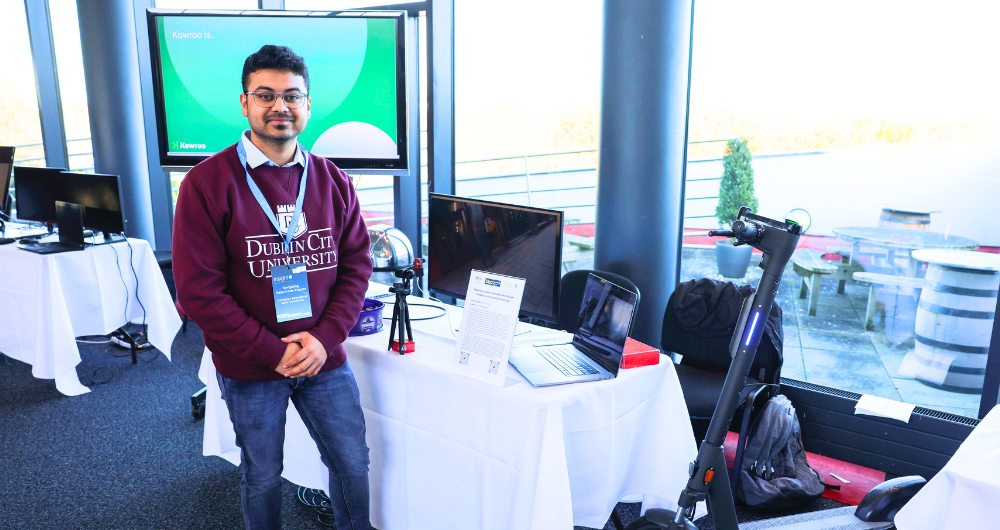
By Chinmaya Kaundanya, Insight at DCU
As a Ph.D. researcher affiliated with Luna Systems, a company at the forefront of developing Computer Vision (CV) AI solutions, I have recently led an academia-industry collaboration regarding an important project aimed at improving the safety of two-wheeler riders in India. This initiative is crucial, given the massive scale of the Indian two-wheeler market and the significant safety challenges it presents.
At the heart of this project is the development of a custom dataset, specifically tailored to the perspective of two-wheeler riders – an area where existing data is notably lacking. Our primary objective is to create a benchmark-level Advanced Rider Assistance Systems (ARAS) dataset for two-wheelers, a first of its kind. To achieve this, I initiated and oversaw a collaboration between my company and my undergraduate alma mater- Marathwada Mitra Mandal’s College of Engineering (MMCOE) affiliated with Pune University in India.
A key aspect of this collaboration involved engaging students from the university. These third-year computer science undergraduates were tasked with mounting cameras on their scooters and bikes to record videos during their rides. The footage obtained from these rides is intended to train AI models and test various rules for ARAS applications such as headway monitoring, blind spot detection, and critical collision warning.
My role in this collaboration was multifaceted. I was responsible for setting up the partnership under the condition that the students would assist in collecting and building the dataset, which would be mutually beneficial. The students not only got an opportunity to work on an industry-level AI project pipeline but also gained practical experience in data collection and labeling. They would later use these images and ground truths to train AI models for applications such as traffic sign detection and recognition, or object tracking algorithms for vehicle trajectory estimation.
Over two months, I closely interacted with the students, guiding them from the project’s inception to the execution of various tasks. An important step was camera mounting and calibration on the two-wheelers. I assisted them in selecting the appropriate equipment and successfully mounting the cameras at the right angles and positions. The subsequent step involved camera calibration, crucial for setting rules for various ADAS applications. Along with a colleague from my company, I taught the students how to calibrate the camera using a chessboard pattern to record extrinsic camera parameters, which could then be combined with intrinsic parameters to accurately interpret and analyse the spatial relationships between the 3D real-world coordinate system and the camera coordinate system. To deepen their understanding, we conducted a workshop on camera geometry models, equipping them to calibrate any type of camera in the future.
The next phase involved riding the two-wheelers to collect data. I personally recorded several videos using the same mounting and camera settings to address any queries from the students and help them kickstart this task.
The motivation for this project stems from the alarming statistics in India’s latest road safety report. According to a report in Zag Daily https://zagdaily.com/opinion/by-the-end-of-this-article-one-2-wheeler-rider-in-india-will-never-return-home/in 2022, two-wheeler accidents accounted for 75,000 fatalities, representing 44.5% of all road deaths and an 8% increase year-over-year. These tragedies cost the Indian Government 3% of its annual GDP.
Our approach utilises a camera-based ARAS system to detect when a two-wheeler is in a heightened risk state or suboptimal road position. Our philosophy centers around nudging the rider toward safer positions, akin to having a riding instructor providing constant guidance. This method aims to significantly reduce the bike’s exposure time in risky scenarios and heighten rider awareness about positioning.
Applying a CV-centric solution in the challenging Indian road environment is no small feat. Congested streets, limited road markings, and unpredictable behaviours create a uniquely challenging setting. However, our solution is not only scalable but also context-aware, providing reliable prompts that encourage safer riding practices.
This project represents a significant step in using cutting-edge technology for societal benefit, specifically addressing the urgent need for enhanced two-wheeler safety in India. It is a testament to the power of collaboration between academia and industry in tackling real-world problems with innovative solutions.